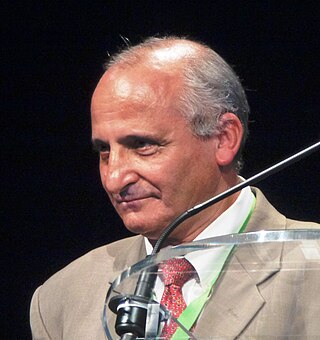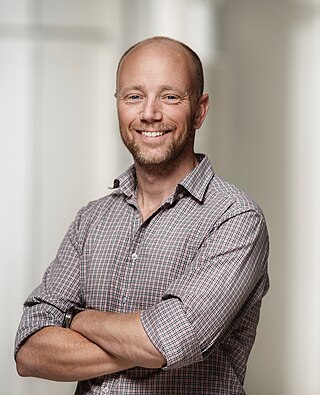
Ernő Rubik is a Hungarian inventor, widely known for creating the Rubik's Cube (1974), Rubik's Magic, Rubik's Magic: Master Edition, and Rubik's Snake.

Shuji Nakamura is a Japanese-American electronic engineer and inventor of the blue LED, a major breakthrough in lighting technology. Nakamura specializes in the field of semiconductor technology, and he is a professor of materials science at the College of Engineering of the University of California, Santa Barbara (UCSB).
Vladimir Haensel was an American chemical engineer who invented the platforming process - a platinum catalytic process for reforming petroleum hydrocarbons into gasoline. In addition, he was influential in the creation of catalytic converters for automobiles.

Rachid Yazami is a Moroccan scientist, engineer, and inventor. He is best known for his critical role in the development of the graphite anode for lithium-ion batteries and his research on fluoride ion batteries.

Ajay V. Bhatt is an Indian-American computer architect who produced several widely used technologies, including USB, Platform Power Management architecture, and various chipset.

Christofer "Chris" Toumazou, CEng is a British Cypriot electronic engineer. He is perhaps best known for inventing a fast and portable means of genome sequencing, following his 13-year-old son's diagnosis with end stage kidney failure through a rare genetic mutation.
Michael Tompsett is a British-born physicist, engineer, and inventor, and the founder director of the US software company TheraManager. He is a former researcher at the English Electric Valve Company, who later moved to Bell Labs in the United States. Tompsett invented CCD imagers and designed and built the first ever video camera with a solid-state (CCD) sensor. Tompsett received the Queen Elizabeth Prize for Engineering in 2017, with Eric Fossum, George Smith, and Nobukazu Teranishi. Tompsett has also received two other lifetime awards; the New Jersey Inventors Hall of Fame 2010 Pioneer Award, and the 2012 IEEE Edison Medal. The thermal-imaging camera tube developed from his invention also earned a Queen's Award in 1987.

Sidney Pestka was an American biochemist and geneticist. A recipient of the National Medal of Technology, he is sometimes referred to as the "father of interferon" for his groundbreaking work developing the interferons as treatments for major diseases such as hepatitis, multiple sclerosis, and cancer. Pestka was part of the team working on research involving the genetic code, protein synthesis and ribosome function that led to the 1968 Nobel Prize in Physiology or Medicine received by Marshall Warren Nirenberg.

John Mikael Holtz Elvesjö, is a Swedish entrepreneur and inventor.

Akira Yoshino is a Japanese chemist. He is a fellow of Asahi Kasei Corporation and a professor at Meijo University in Nagoya. He created the first safe, production-viable lithium-ion battery, which became used widely in cellular phones and notebook computers. Yoshino was awarded the Nobel Prize in Chemistry in 2019 alongside M. Stanley Whittingham and John B. Goodenough.

Science and technology is one of Hungary's most developed sectors. The country spent 1.4% of its gross domestic product (GDP) on civil research and development in 2015, which is the 25th-highest ratio in the world. Hungary ranks 32nd among the most innovative countries in the Bloomberg Innovation Index, standing before Hong Kong, Iceland or Malta. Hungary was ranked 36th in the Global Innovation Index in 2024.
Gjorgji Filipov is a Macedonian diplomat. In 2014 he is the Ambassador of Macedonia in Vienna, Austria as well as Ambassador of Macedonia to Japan and Slovakia. He was founder and first director of the Macedonian State Office of Industrial property from. He holds a PhD in the field of Industrial Property. The title of the doctoral thesis was:"Industrial Property as an Indicator for Technological Development“.

Lion lights are devices designed to scare away lions from a set perimeter to protect cattle and other herd animals. Lion lights were originally invented by Richard Turere to prevent night attacks by lions on his family's cattle, which also helps prevent lions from being hunted in retaliation by poachers.

Peter Landrock is a Danish cryptographer and mathematician. He is known for his contributions to data encryption methods and codes. Landrock has been active since the 1970s as research scientist and faculty member for Cambridge University and the University of Aarhus and others, and was active for Microsoft and Cryptomathic. He has been visiting professor at Oxford University, Leuven University and Princeton University.

Ursula Keller is a Swiss physicist. She has been a physics professor at the ETH Zurich, Switzerland since 2003 with a speciality in ultra-fast laser technology, an inventor and the winner of the 2018 European Inventor Award by the European Patent Office.

Xin Zhang is a Distinguished Professor of Engineering at Boston University (BU).
Adnane Remmal is a Moroccan pharmacology professor, senior researcher, and entrepreneur in the field of biotechnology at Sidi Mohamed Ben Abdellah University. His works focus on fighting antimicrobial resistance, one of the major threats to public health in both developed and emerging countries. Among other results, he has successfully patented a solution to boost antibiotics against antibiotic-resistant bacteria, and an alternative to replace antibiotics in poultry feed. In 2017, he was the recipient of the European Patent Office (EPO) Popular Prize category award. EPO President Benoît Battistelli declared "The public vote for Adnane Remmal recognises his contribution to fighting the growing threat of antibiotic-resistant microbes."

Elmar Mock is a Swiss watch engineer with specialized knowledge in polymers, an industrial designer, and inventor.

Helen Lee is a Chinese-born, British–French medical researcher who won the European Inventor Award 2016 in the Popular Prize category for inventing diagnostic kits for resource-poor regions of the globe. She is the CEO of Diagnostics for the Real World. She has been based at the University of Cambridge since 1996.
Erin Smith is an American entrepreneur and inventor. She is the founder of FacePrint, a medical technology venture focused on developing facial recognition software for assisting in the diagnosis of Parkinson's disease. In 2018, Smith was recognized as a Thiel Fellow, and in 2022, she was awarded the first place Young Inventors Prize by the European Patent Office.














